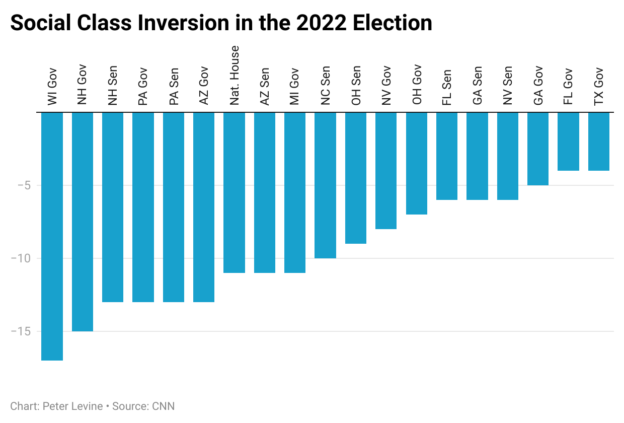- Facebook54
- Twitter3
- Total 57
I’ve argued that democracy is dangerously threatened when influential left parties rely on upper-income voters and influential right parties depend on working-class support. In such cases, the left parties block significant progressive change and frustrate disadvantaged constituencies, while the right shifts from libertarian to chauvinist policies.
There is evidence of this class inversion in many democracies, including (among others) France and Germany. In the US, the inversion is partial, because race, income, and education push in different directions. This partly explains the incoherent positions of both major parties. Democrats draw highly educated whites and people of color; Republicans attract whites at both ends of the socioeconomic scale.
I have graphed the difference between Democratic support among college graduates and non-college graduates by state and candidate in 2022. If college is a proxy for the upper portion of the socioeconomic scale, then Democrats should perform better among non-college graduates, but the opposite happened in every case.
At a national scale, the Democrats won a majority of voters with college degrees (54%), but a minority of those without college degrees (43%). That 11-point gap is evidence of one kind of class inversion. On the other hand, the Democrats won a majority of voters with household incomes below $50,000 (52%) and a minority of those above that threshold (45%) and above $100,000 (46%). They drew half the white college graduate vote (50%), just 32% of the white non-college vote, and 68% of people of color with or without college degrees. Again, the picture is mixed.
There were some interesting differences by state. The class inversion was most pronounced in Wisconsin, where Gov. Evers won 62% of the college vote and 45% of the non-college vote on his way to reelection: a 17-point gap. Evers drew the support of only 37% of white voters without college degrees, 59% of white voters with college, and 83% of voters of color, regardless of education.
In the Ohio and Pennsylvania Senate races, the Democratic candidates explicitly courted working-class voters of all races. These campaigns were experiments in reversing the class inversion. Both Democrats lost non-college voters, and neither performed much differently from the national average with that demographic group. (Ryan got 34% of non-college white votes; Fetterman got 38%.) Of course, they had different opponents. JD Vance made an explicit pitch to non-college whites in Ohio that may have worked for him, whereas Mehmet Oz lost overall in Pennsylvania.
In Michigan, traditionally a blue-collar state, the Democrats performed very well. The interplay of class and race was particularly evident in that state’s results, with Gov. Whitmer drawing 42% of non-college whites, 60% of college whites, and 82% of non-college people of color. In other words, she reflected the Democrats’ formula of educated whites plus all people of color. That formula can win elections but makes Democrats dependent on an upscale portion of their electorate.
In Florida, the Republicans simply performed better than in other states. The demographics there are also somewhat unusual. The Exit Polls report all people of color as one category, and in Florida, that means more Latinos than in some other states. Notably, DeSantis won almost half of voters of color with college degrees (48%), who represented 14% of the state’s electorate. But he got 70% of white voters without college.
See also: class inversion as an alternative to the polarization thesis; social class in the French election;
